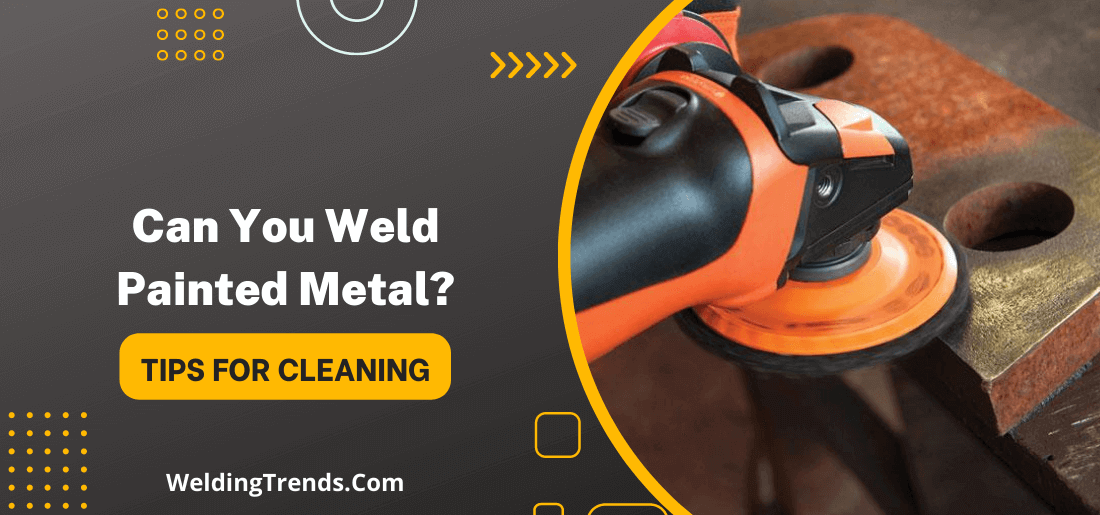Welding painted metal can be a tricky business. The paint can often create a barrier between the metal and the welding arc making it difficult to create a weld.
In some cases it’s even possible to damage the paint with the heat of the welding arc. But with a little preparation you can easily weld painted metal without any problems.
In this blog post, we’ll discuss why it’s important to clean the metal before welding and how to go about doing so. We’ll also take a look at some of the best ways to weld painted metal. So, whether you’re new to welding or a seasoned pro, read on for tips on how to weld painted metal like a boss!
Can You Weld Painted Metal? Why You Need to Clean?
Yes, you can weld painted metal but it is not always the best idea. Welding over paint can cause problems with the weld quality and the paint can interfere with the welding process.
It is best to remove the paint before welding whenever possible.
Cleaning metal before welding is important because it helps ensure that the weld will be of good quality. Any dirt, grease or other contaminants on the metal can cause problems with the weld.
In addition, it is important to clean metal before painting it so that the paint will adhere properly. Otherwise, the paint may not adhere well and it can start to flake off.
There are a few different ways to clean metal including using a wire brush, sandpaper or chemical cleaners.
A wire brush is the best method for cleaning metal before welding. It will remove any rust, paint or other contaminants from the surface of the metal.
Make sure to clean both sides of the metal so that there are no contaminants present before welding. If you can’t clean the metal before welding you can try using a diffuser shield. This will help to protect the weld from any contaminants on the metal surface.
Why do you need to clean metal before welding?
Cleaning metal before welding is an important step for successful welds. It ensures that the surface of the metal is free from rust, dirt, oil and other contaminants. This helps to create a strong bond between the metals being welded and prevent potential defects in the finished weld.
Additionally, it creates a more visually appealing result. When metal is not clean, the weld may be weak and could lead to future problems. Additionally, it can create a hazardous work environment due to debris that becomes airborne when welding unclean metal.
Cleaning metal before welding also increases the life of your tools as dirt and grime can cause wear and tear on your equipment. Proper preparation helps ensure that your welds are strong and last a long time.
Overall, cleaning metal before welding is an important step in the process to ensure successful welds and prevent potential hazards.
Benefits Of Cleaning Metal Before Welding
There are some benefits of cleaning metal before welding:
- It helps to create a stronger bond between the two pieces of metal.
- It can help to prevent welding defects, such as porosity and incomplete fusion.
- Cleaning also helps to improve the appearance of the weld.
- Finally, it is generally good practice to clean all materials before welding regardless of whether or not they are required for the specific application. This helps to ensure that the welder has a clean working environment and that any contaminants present will not cause problems during the welding process.
Tips For Cleaning Metal Properly
- Use a mild detergent with warm water and a soft cloth to clean surfaces.
- For tougher stains use a special metal cleaner or polish available at your local hardware store.
- Avoid using abrasive tools such as steel wool, scouring pads and harsh chemicals on metals as this can cause scratches and tarnishing.
- Dry metals immediately after cleaning them to avoid water spots.
- If you notice any rust remove it with a mixture of equal parts vinegar and salt before polishing the metal surface.
- To clean jewelry or other delicate items use a damp cloth and mild soap to wipe away dirt and oil.
- For silverware or cutlery use a soft brush to remove food particles before wiping them with a damp cloth.
- Store metals in a dry place and protect them from direct sunlight to prevent tarnishing.
- Use wax polish on metal surfaces periodically to keep them shining brightly.
- Finally, seek professional help if the metal is too dirty or damaged to clean properly.
These tips should help you keep metal items looking clean and shiny. With regular
How to weld painted metal?
Painted metal can be a bit tricky to weld but with the right preparation and technique, it can be done successfully. Here are some tips on how to weld painted metal:
- First, make sure that the paint is in good condition and is not peeling or flaking off. If the paint is in poor condition it will need to be removed before welding.
- Second, clean the surface of the metal to be welded. Any dirt, grease or debris on the surface of the metal will cause problems when welding.
- Third, use a low setting on your welder when starting. This will help prevent burning through the paint. Once you get comfortable with the welding process, you can increase the setting.
- Fourth, use a short welding arc. This will help prevent melting through the paint.
- Fifth, weld slowly and evenly. This will help prevent warping or distorting the metal.
Welding painted metal can be tricky but with the right preparation and technique, it can be done successfully.
Follow these tips to get the best results when welding painted metal. Cleaning and maintenance metal can remain in pristine condition for many years.
FAQs – welding over paint
Can you spot-weld over paint?
Yes, you can spot-weld over paint. However, the paint must be in good condition and free of any contaminants such as oil, grease or rust.
If the paint is not in good condition it can weaken the bond between the two pieces of metal and cause the spot weld to fail.
What happens if you weld over paint?
The heat generated from welding can cause the paint to crack, bubble and melt. This can create a hazardous environment as the melting paint may release toxic fumes into the air. In addition, cracking or blistering of the paint can lead to moisture getting trapped underneath which could cause rust and corrosion.
For these reasons it is best to remove as much of the paint as possible before welding to ensure a safe and effective weld. If this is not possible extra precautions should be taken when welding to minimize any potential hazards.
Can you MIG weld over the paint?
MIG welding over paint can be done but it is not recommended. The heat from the weld could cause the paint to bubble and create bubbles underneath the paint which could lead to rust forming. It is better to remove any paint from the area that you are going to be welding so as not to have any issues down the road.
If you do choose to weld over paint make sure that you use proper heat control when welding and move the weld gun quickly so as not to overheat the area. It is also important to take necessary safety precautions such as wearing protective clothing and a face shield.
Lastly, it is best practice to cover any areas around the weld with a tarp or other material to protect them from sparks and spatter.
Should steel be painted before or after welding?
It is generally recommended that steel be painted after welding, as this helps to protect the weld and prevent rusting. However, in some cases it may be necessary to paint before welding to prevent heat damage to the paint. If you are unsure it is always best to consult with a professional.
What paint to use before welding?
Before welding it is important to remove any paint or other materials that could cause problems. The best way to do this is to use a paint stripper.
This will remove the paint quickly and easily without damaging the metal underneath. If you don’t have a paint stripper you can also use a grinder or sandpaper to remove the paint.
However, this will take longer and is more likely to damage the metal. Once the paint is removed you should clean the area with a degreaser to remove any oil or other contaminants.
Can you weld primed steel?
Primed steel can be welded but it is important to remove the primer before welding. The primer contains chemicals that can produce toxic fumes when heated. It is also important to clean the area before welding to remove any oil or other contaminants.
Final Words
Metal welding is a process of fusing two pieces of metal. To achieve the best weld possible it’s important to start with clean metal surfaces. Welding painted metal is possible but it can lead to contamination of the weld and affect its strength.
It is recommended to remove the paint from the area to be welded before the welding process to ensure a strong and clean weld. By removing any oils or contaminants from the surface of the metal you can create a stronger weld that is less likely to break or crack.




